Suzi Fadel Nassif is a contemporary artist born in Lebanon, but has been based in Dubai for over twenty years. From a very young age, Suzi was aware of her orientation towards visual arts. She’s a self taught artist, who taught herself and explored different techniques and mediums whilst Lebanon was going through rather difficult War Times.
Driven by the artistic expressions of Salvador Dali, she developed a keen eye for minute details, analyzing colors and texture. Journeying into groundbreaking abstract impressionism and surrealism, Suzi gains inspiration from the interconnectedness of people from different walks of life, cultural diversity, mysteries of existence and the semblance of emotions.
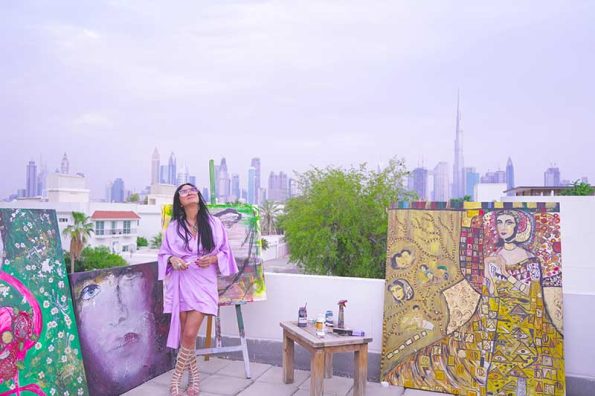
Suzi has a vivid imagination, an excellent memory and a unique sensitivity when it comes to lots of subject matters. She stores images, emotions, facial expressions, words, poems in her mind like an organized catalogue. With every painting, she tells a different story, sometimes from her mental catalogue, other times from a present reality or surreality!
She focuses a lot on the eyes, which are the most prominent element in her portraits. They speak to her and to the others about the beauty or the struggle of a personal experience in a culture or in a society. Suzi paints her dreams, your dreams, her reality, your reality, every tragedy and comedy that exists around us. With every portrait, she portrays a situation, a mood, or how she imagined it to be. it’s important to Suzi to breath life into a painting, to scream the silence of the viewer where they can relate to her art in a certain way.
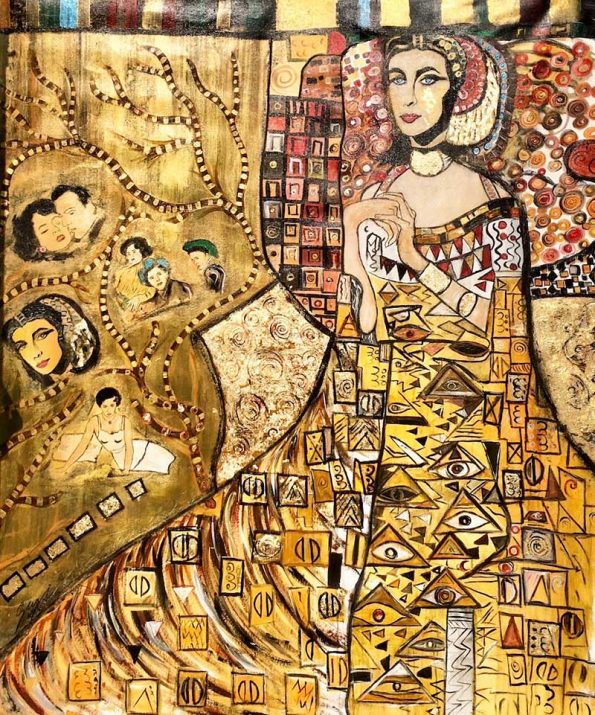
Suzi is the legendary storyteller Scheherazade in her own artistic way where colors, faces, phases, mediums, brushes, canvas and her are the main vessels to tell stories of more than one thousand and one nights!
«From a very young age, I was aware of my orientation towards visual arts. My notebooks were filled with various sketches, artistic fonts and vivid colors. I took and continue to take pleasure in finding beauty in everything. My eyes and mind have become accustomed to admiring and analyzing details, colors and textures. I have always known I would follow my artistic dreams, wherever they may take me. Perhaps what inspired me the most is Paulo Coelho’s quote: “When you want something, the entire Universe conspires to help you to achieve it”.
Innovative diversification is the cornerstone of my art oeuvres. From black and white to vivid colors, mild to sharp and sassy strokes, and different styles and mediums, my paintings tell a unique story with deep emotional echoes.
In the words of Picasso: “Painting is a blind man’s profession. He paints not what he sees, but what he feels, what he tells himself about what he has seen”.
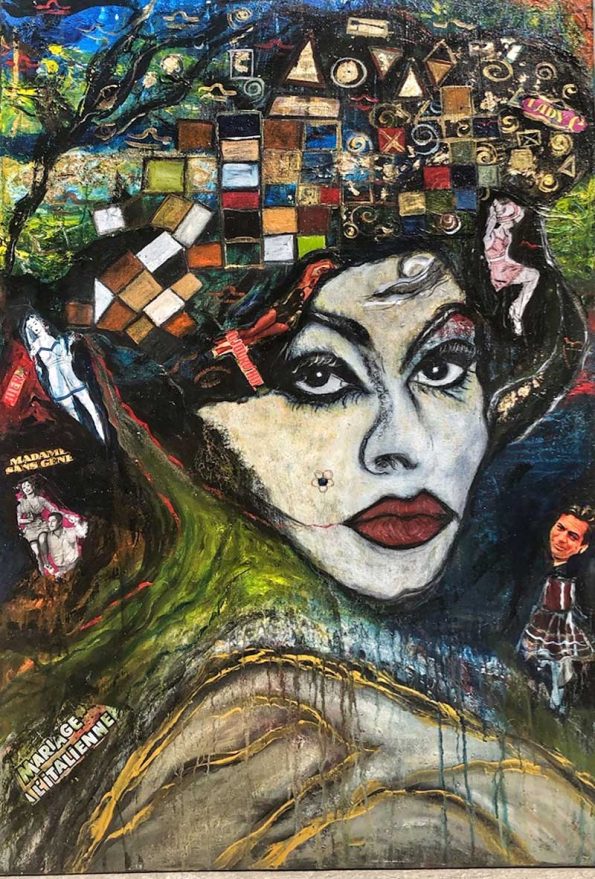
About her Collection:
Cultural diversity, mysteries of existence and the semblance of emotions are elements that connect together into one unique artistic inspiration which famed artist Suzi Fadel Nassif expresses through her artwork.
Driven by an insatiable love for life, she decided to take her artistic inspiration beyond the canvas and walls, bringing her art closer to people’s lives, through an individually curated capsule collection of wearable pieces and home accessories representing a unique artistic statement of her masterpieces prints.
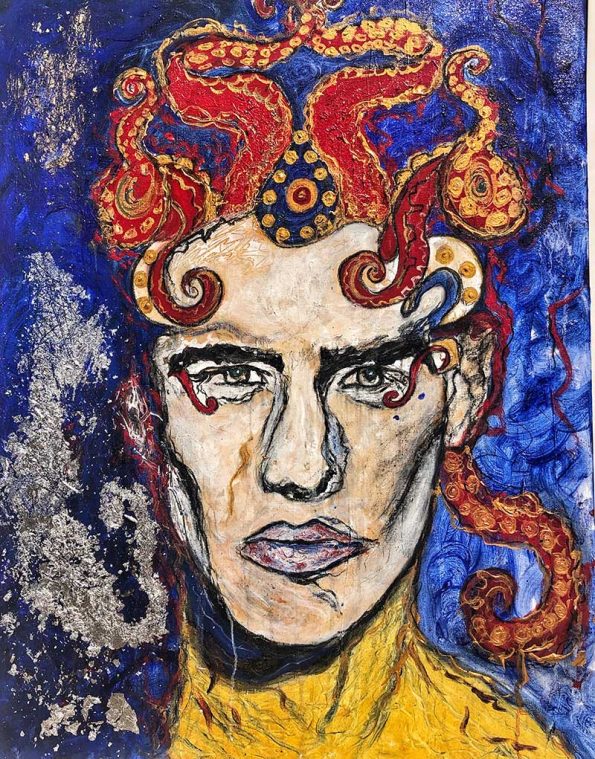
“Art is not what you see, but what you make others see”. This sentence of the extraordinary Edgar Degas is really interesting. What do you think about it?
Art evokes emotions, whether they are happy, sad, disturbing or exciting. Art makes you feel and art makes you think. Art can make you question, not only the artist’s interpretation or message, but also your own feelings. It is a strong, visual way to convey emotions and ideas indirectly, leaving it to an individual’s interpretation.
My art is the offspring of inspiration and internal waves of time-specific emotions. The painting itself reflects its vision on the viewers, so that the brush strokes become part of their imagination, and through that a personal bond is formed and my message is delivered. Art, as Borges said, is an interaction between the viewer and the artist therefore the artist can only manifest that what they see is what the viewer sees.
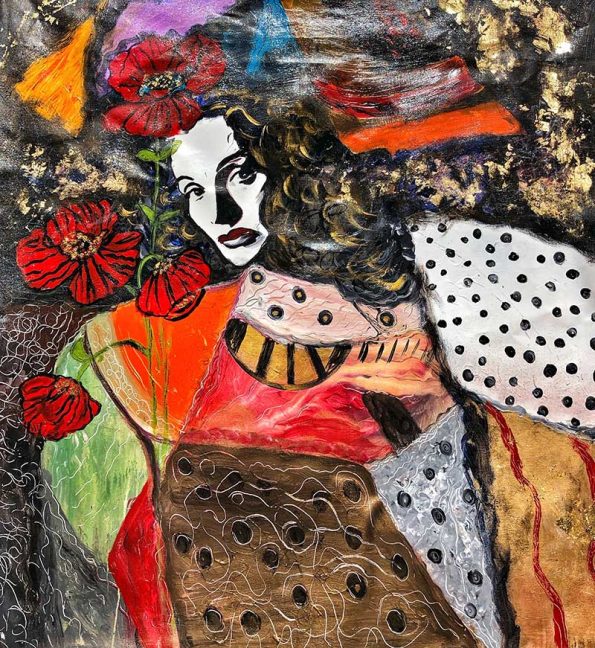
It is really curious that the majority of artists have begun as self-taught artists and have reached a maturity that is amazing. Why do you think that the artists prefer to learn by themselves?
Art schools teaches every new artist a set of technical skills as an activator leading every individual onto the path of self-discovery that makes them unique. Although, in reality, a true artist is born with an innate sense and abundance of emotions that can only be expressed visually. An artist paints their feelings through life itself; it is a reflex alike breathing.
Historically, it was easier to identify a self-taught artist compared to present day. An artist brought up with few resources and opportunities would have no choice but to teach themselves how to master their skills. There would be no one to teach him color theory and he would not be privy to the techniques used by previous generations. More often than not, this was evidently visible in their work. However, in modern times, with readily available online course and YouTube tutorials and even libraries, anyone can self-educate themselves in art history and technique.
Vincent Van Gogh and Paul Gaugin, Frida Kahlo and many other artists are prominent examples of such artists. Self-taught artists are free to try what they think is right without following any rules that hinder their growth. Don’t get me wrong, schools don’t kill artistic evolution, but most curriculums focus on analytics and logic which have a limited input on creativity. The main difference between the self-taught and trained artists is the freedom they have. Van Gogh didn’t have any fear to try anything that came to his mind which is what created a new movement in the arts.
Being a self-taught artist and an alien to the art world was very challenging to me in the beginning. I had to independently learn various techniques, styles, and mediums. The struggle was getting harder and harder each day, I felt like Alice in Wonderland; totally lost in a world of colors, creativity and self-critic! It was a labyrinth but totally worth it! I realize the learning process never ends; I call it: “the evolution process”.
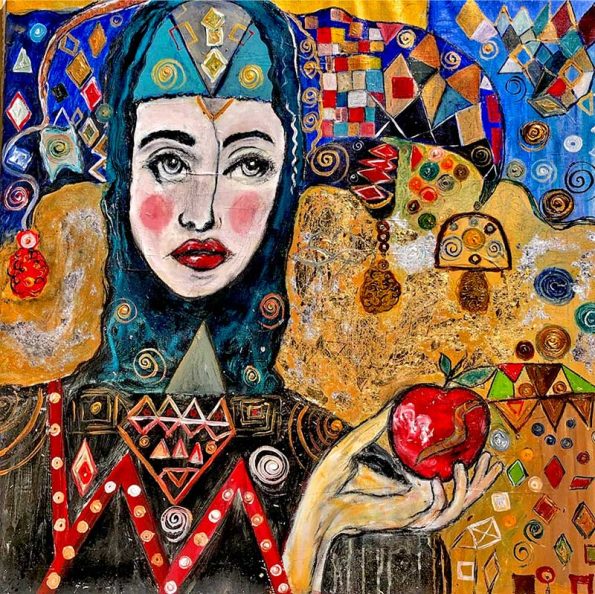
Dreams, reality, emotions… these words express your way to feel and to work. I would like to know more about all of this.
Art is the language of the soul, it can be one of the most effective tools to portray your inner feelings; it is an exposure of one’s inner self, thoughts, and feelings as a subject matter. Emotions are the motivators and the energy that is waiting to burst into color.
Art is a magical result of my feelings, emotions, experiences, and beliefs; the outer manifestation of an inner state. It is a collective result of what I consciously and subconsciously grasp on a daily basis using all my senses. I am totally inspired by our personal “reality shows” that we experience in our everyday lives when we read articles, or watch the news or movies, listen to speeches, or conversation with others or even with ourselves. As an artist, I sometimes portray it in a face, a figure or use a certain color, texture or detail to create an art piece based on this reality!
I quote Van Gogh: “The emotions are sometimes so strong that I work without knowing it”
What do we become if we live without a dream, an illusion, a fantasy? As an artist and a human being, I live inside my head most of the times, between colors, textures, darkness, light, surreal, real, a planet of various emotions, and different dimensions.
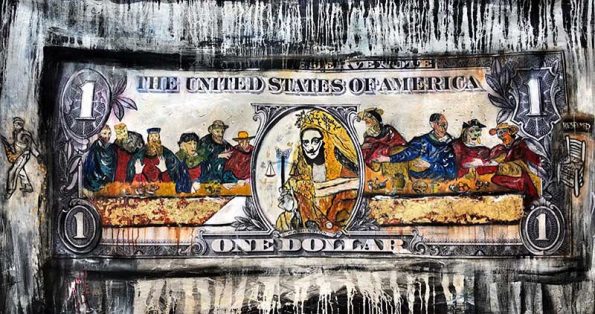
Salvador Dalí is one of the most celebrated artist in the world and his influence is found in your artworks. What have you felt about him and his artworks?
My journey in art was fiercely influenced by the masters of art. Salvador Dalí was my first muse, I lived through his paintings and even copied the mind-bending artwork “Fertility”. I portrayed Dalí in all his states, visited his museums around the world and even had a taste of his life at his home in Cadaqués, Catalonia. I was inspired by his art and how he takes the viewer on reality-twisting journeys motivating me to think outside the box. His work is so diverse and unlike anything else I have ever seen; it has taught me that as long as I like my creation then I am doing everything right. His dreamlike thought processes, enhanced by his Freudian obsession, led to the production of some astonishing, highly evocative and meaningful pieces that feeds the imagination and makes the viewer think deeply about what they’re looking at. Dalí may have been slightly eccentric to some, but his artwork was his personality; what you saw was what you got, and to me, surrealism is eccentricity. The name Dalí is magic to me.

When I saw your different artworks I thought immediately about a storyteller of a movie.
Are you creating like a film director when you begin a new work?
Yes, I could be like Scheherazade, a storyteller. Every painting is a storyteller with a unique chapter. I am always providing clues and over time these clues add to the larger story. My passion is that my art evokes emotions in the viewer and allows them to engage in the story in their own unique way.
This process of creation is never intentional. It thrives on the utter un-expectancy of life behind its hidden corners; a single emotional moment could awaken the artist in me. Whether it’s love, hate, grief, despair, hope, dreams, wishes, memories, happiness etc. everything serves its part in Art. That’s the beauty of it!
For me, experiencing any of these emotions at their highest peak would gravitate me to my canvas as it is my mean of expressing what words cannot express. It is never planned nor directed, it just unconsciously happens, and the story is revealed.

I have realized that you have different styles. Why? How do you connect with each one of them?
Many artists experience transition during their times depending on their will and inspiration. For example Salvador Dalí’s transformation was as miraculous as Picasso.
If we are talking about my current art period and the black and white period, yes it could be different in terms of colors and expressions, but my artistic signature is quite clear in both periods. I am still myself when I change, and my style is still mine even when its different.
The black and white period was my very beginning in 2014 which was the period after I lost my father – one of life’s lowest points that took a toll on my visual conception. I was interpreting life in black and white. It was a dark phase that prevailed in my art where I interpreted happiness, sadness, anger, joy and a myriad of emotions through void and darkness. The monochromatic repetition was related to representations of melancholy or hopelessness. My portraits were often depicted as Bohemian-type outcast; cold colors, gloomy brush strokes, somber and dark dusky greys, and sickly white.
Today, after confronting all the challenges of this intense year, I am noticing a recent metamorphosis; I am depicting distortion or deconstruction in my sketches and the absolute unknown, the terror, and the new reality. Is it going to be the new meaning or genre translated in my Art? I guess time will tell! Perhaps, it’s time for the next phase of my evolution.
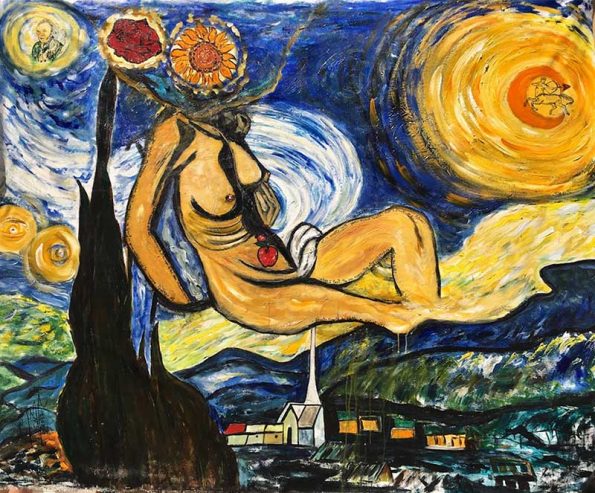
7.- You describe yourself as Scheherezade because of the way of developing your artistic dream. What is really behind the Scheherezade dream?
Tale of One Thousand and One paintings.
Art is an expression of our way to feel life. Do you agree?
Art is a multi-faceted medium of creative expression. It is a universal language that allows for a deeper, more immediate and more expressive form of communication (a picture is worth a thousand words). The physical nature of art also allows our entire body, along with our mind, to participate in the act of expression. This facilitates the involvement of both our conscious and unconscious thoughts. Art allows us to communicate with our entire being as words are sometimes not enough. It is therefore the perfect medium for emotional communication; in a way it is a form of telepathy.
Suzi Nassif and her art. Where do you think that you will be in the next five or ten years?
I am in a constant evolution mode; my art is continually evolving from the day I started till this moment in time. There is no time frame for me. It might take a year or an eternity, as long as I keep on challenging myself and stepping out of my comfort zone to create universal artwork that speaks all languages – “The Masterpiece”. I paint to reach a common theme, a common thread, a common emotion for a better world.
The evolution of an artist is part of his/her personal development. What do you think about this?
One’s artwork is like a mirror containing a reflection of who they are; their true self! T.S. Eliot wrote in Little Gidding: “We shall not cease from exploration, and the end of all our exploring will be to arrive where we started and know the place for the first time.”
As artists and creators, we’re continually improving our work. Not satisfied to remain still, we explore and experiment. I believe we move through developmental cycles much like the stages of human development. Even as you develop into, there’s no endpoint much like striving to perfection. Yet, Picasso never achieved full mastery. Mozart never achieved full mastery. Nobody can achieve perfection. But we witnessed how they evolved in many aspects of their art career and self-growth.
The ability to imagine and to take that imagination and make it into reality is one of the things that is really distinctive about humans. We have the ability to take nothing and turn it into something magical. Something that adds value to another person’s life. Something that brings out the best in ourselves. That’s creativity, that’s evolution, that becomes automatically a personal identity.
Art Events & Exhibitions: